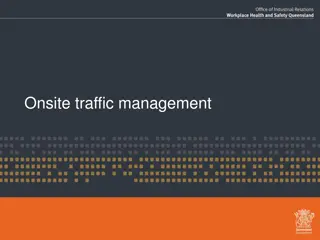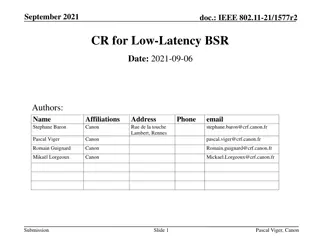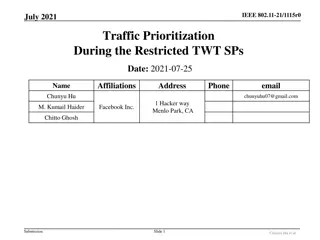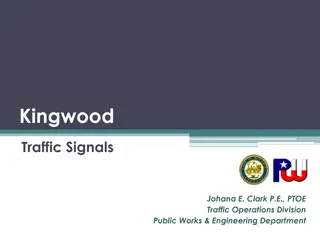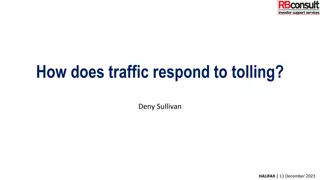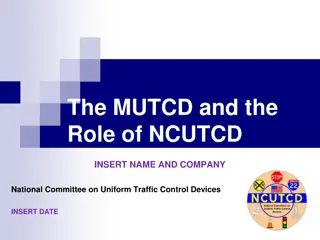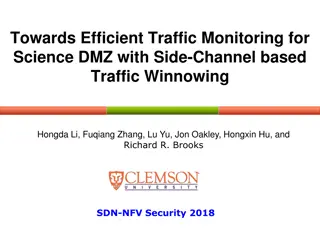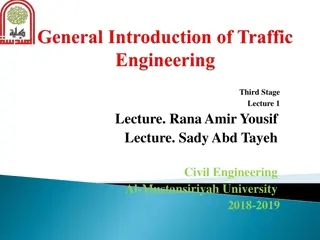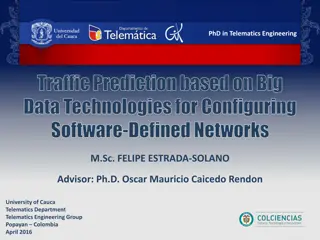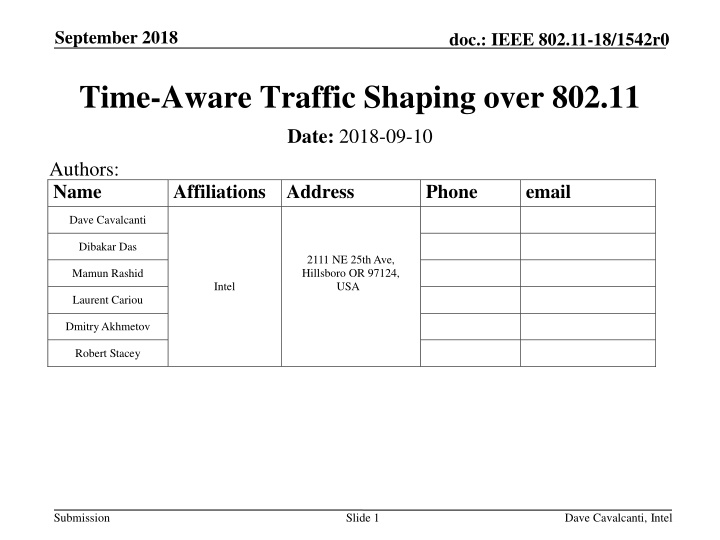
Enhancing Wi-Fi Performance for Time-Sensitive Applications
Explore how IEEE 802.11 proposes Time-Aware Traffic Shaping to improve latency predictability for time-sensitive applications like gaming and industrial automation over Wi-Fi networks. Discover challenges, requirements, and potential solutions for optimizing performance in this detailed document.
Download Presentation

Please find below an Image/Link to download the presentation.
The content on the website is provided AS IS for your information and personal use only. It may not be sold, licensed, or shared on other websites without obtaining consent from the author. If you encounter any issues during the download, it is possible that the publisher has removed the file from their server.
You are allowed to download the files provided on this website for personal or commercial use, subject to the condition that they are used lawfully. All files are the property of their respective owners.
The content on the website is provided AS IS for your information and personal use only. It may not be sold, licensed, or shared on other websites without obtaining consent from the author.
E N D
Presentation Transcript
September 2018 doc.: IEEE 802.11-18/1542r0 Time-Aware Traffic Shaping over 802.11 Date: 2018-09-10 Authors: Name Dave Cavalcanti Affiliations Address Phone email Dibakar Das 2111 NE 25th Ave, Hillsboro OR 97124, USA Mamun Rashid Intel Laurent Cariou Dmitry Akhmetov Robert Stacey Submission Slide 1 Dave Cavalcanti, Intel
September 2018 doc.: IEEE 802.11-18/1542r0 Abstract In a previous presentation (doc#: 802.11-18/1160r0) we showed that 802.11 latency can be very low, but predictability (reliability) can be improved - This would enable 802.11 to address many time sensitive applications (gaming, robotics, industrial automation, etc.) Many issues raised with current products can be resolved with optimized implementations, or by implementing features already defined in 802.11. 802.11 could go further on congestion control solutions to address worst cast latency predictability to ensure 802.11 competitiveness - Extend 802.1 TSN features: Time-Aware shaping (802.1Qbv) over 802.11 In this presentation we discuss the Time-Aware shaping (802.1Qbv) concept and how it can be used to control congestion in 802.11 We also provide preliminary performance results in a single BSS case Submission Slide 2 Dave Cavalcanti, Intel
September 2018 doc.: IEEE 802.11-18/1542r0 Outline Time sensitive application examples Latency challenges 802.1 TSN overview Time-Aware (802.1Qbv) traffic shaping Time-Aware traffic shaping over 802.11 Performance evaluation Conclusions Submission Slide 3 Dave Cavalcanti, Intel
September 2018 doc.: IEEE 802.11-18/1542r0 Time Sensitive Applications Examples Limiting worst case latency (also over the Wi-Fi link) is the main issue Real-time mobile gaming Wireless control system Latency/jitter cause lagging/bad user experience Latency/jitter may cause instability of the system Submission Slide 4 Dave Cavalcanti, Intel
September 2018 doc.: IEEE 802.11-18/1542r0 Requirements for the Wi-Fi Network Application Worst Case Latency Application PER Throughput Requirement *Mobile gaming 10 ms 0.1% Low (0.5-1Mbps) **Wireless control, robotics, AGVs Class A: 10-50ms Class B: 1-10ms Class C: <1ms 0.1 0.0001% (depend on specific application) Low Wireless VR 5 ms 0.1% High Predictable worst case latency with high probability is major improvement area for Wi-Fi. *Doc#: 802.11-18/1419r4 **Doc#: 802.11-18/1160r0 Submission Slide 5 Dave Cavalcanti, Intel
September 2018 doc.: IEEE 802.11-18/1542r0 Latency Challenges 802.11 latency can be very low without congestion Basic sequence: EDCA+DATA+ACK (~100 s s for 100 bytes) This enables a wider range of very low latency use cases (mobile gaming, industrial Class A/B under managed networks) Congestion is the main challenge in enabling more predictability of worst case latency Congestion within BSS is easier to address with congestion control solutions Congestion with managed OBSSs can also be addressed Congestion with unmanaged OBSSs is very hard to control Time-aware traffic shaping can enable better congestion control 802.1Qbv defines a solution for Ethernet-based TSN (Time-Sensitive Networking) As with other 802.1 capabilities, similar concept can be extended to 802.11 This also enables better integration of 802.11 with Ethernet-based TSN Submission Slide 6 Dave Cavalcanti, Intel
September 2018 doc.: IEEE 802.11-18/1542r0 IEEE 802.1 Time-Sensitive Networking (TSN) Standard Ethernet with Synchronization, small and/or fixed latency, and extremely low packet loss TSN Components Common Standards Time synchronization: Time Synchronization (802.1AS) 802.1AS over 802.11 Timing Measurement (TM) Fine Timing Measurements (FTM) Ultra reliability: Frame Replication and Elimination (P802.1CB) Path Control and Reservation (802.1Qca) Per-Stream Filtering and Policing (802.1Qci) Reliability for time sync (P802.1AS-Rev) Synchronization Reliability Reliability Latency Bounded low latency: Time-Aware traffic shaping (802.1Qbv) Preemption (802.1Qbu/802.3br) Cyclic Scheduling (802.1Qch) Asynchronous Scheduling (802.1Qcr) Dedicated resources & API Stream Reservation Protocol (802.1Qat) TSN configuration (P802.1Qcc) YANG (P802.1Qcp) Link-local Registration Protocol (P802.1CS) Resource Mgmt Zero congestion loss Time-Aware shaping (802.1qbv) over 802.11 (extension to address latency) 802.11aa (SRP over 802.11 for AV) 802.11ak (802.11 links in an 802.1Q network) Credit: J nos Farkas, Ericsson TSNA Conference 2017, http://www.tsnaconference.com/ Submission Slide 7 Dave Cavalcanti, Intel
September 2018 doc.: IEEE 802.11-18/1542r0 Time-Aware Traffic Shaping Scheduling time-critical frame transmissions while avoiding contention with lower priority frames can give low jitter and guarantee worst case latency 802.1Qbv defines Time-Aware shaper for Ethernet switches Queues/Traffic classes Multiple queues are controlled based on a repeating schedule (time, gate open/closed), time reference is provided by 802.1AS Qbv can be very effective, especially for predictable, periodic traffic T T T T T T T T frame selection Transmission time gate open gate open gate closed gate open gate closed Submission Slide 8 Dave Cavalcanti, Intel
September 2018 doc.: IEEE 802.11-18/1542r0 Time-Aware Shaping over Wireless Time-Aware shaping sitting on top of 802.11 MAC can resolve contention within each device and across multiple STAs/AP that share the medium Within the BSS, existing 802.11 MAC/PHY protocols can be used to ensure that the STAs will have time to complete their transmission during the period when the gate is open:EDCA, UL OFDMA, TWT, Example Scenario AP Time-Sensitive Traffic Other Traffic T T T T gates closed AP gate open gate open All gates open gates closed gate open STA 1 (Normal Operation) Shared medium gates closed gate open STA 2 T T T T T T T T The Qbv schedule defines when the gates open/close (implementation specific) The schedule can take into account the 802.11 MAC/PHY mode (e.g. EDCA, 11ax DL/UL OFDMA, TWT, ) STA 2 STA 1 Submission Slide 9 Dave Cavalcanti, Intel
September 2018 doc.: IEEE 802.11-18/1542r0 Simplified TSN Reference Stack Application Transport IP Encapsulation Direct L2 access IP IEEE 802.1 Network Link Layer TSN Capabilities: time sync, time-aware, reservations, and many others IEEE 802.3 (Ethernet) IEEE 802.11 (Wi-Fi) MAC/PHY Media Specific Support required for TSN Capabilities 3GPP/5G (new) 802.11 requirements for Time-Aware (Qbv) capability: Exchange the 802.1Qbv schedule between managed STAs Rules to certify the release of frames from the 802.11 queues according to the 802.1Qbv defined times Submission Slide 10 Dave Cavalcanti, Intel
September 2018 doc.: IEEE 802.11-18/1542r0 Performance Evaluation Single BSS gaming scenario Single AP, 80 MHz channel BW, 2 NSS 16 Gaming STAs: Time-Sensitive traffic Bi-directional periodic streams: 500B UDP packets (worst case packet size according to 802.11-18/1419r4) every 30ms; DL and UL streams are independent 20 Video STAs: BE traffic DL traffic: ~6MB DL packets generated periodically every 4s (models 1080P DASH video streaming application) Goal: evaluate the latency performance of with and without Qbv over different access mechanisms Submission Slide 11 Dave Cavalcanti, Intel
September 2018 doc.: IEEE 802.11-18/1542r0 Simulation configurations Service Interval (5 ms) With Qbv: AP and STAs know the Qbv schedule Gaming traffic is prioritized Other traffic is blocked before and within the period Access within the period: DL: MU OFDMA UL: EDCA, Trigger-Based, or TB (no gaming) + EDCA (gaming) Without Qbv: no prioritization and no reserved period (gaming uses VO, and Video uses VI) SP= 1ms All traffic ... Time-Sensitive (gaming) EDCA access: UL SU Data DL MU Data DL 2 A C k A C k UL 1 UL 2 BA DL 1 SIFS SIFS SIFS SIFS Trigger-based access: DL MU Data UL MU Data UL 2 DL 2 TF BA DL MBA UL 1 DL 1 SIFS SIFS SIFS SIFS SIFS Submission Slide 12 Dave Cavalcanti, Intel
September 2018 doc.: IEEE 802.11-18/1542r0 Results Worst case latency is under 10ms with high reliability with Qbv in this scenario Submission Slide 13 Dave Cavalcanti, Intel
September 2018 doc.: IEEE 802.11-18/1542r0 Conclusions Worst case latency is an important requirement for many time- sensitive applications (gaming, automation, robotics, ) The Time-Aware traffic shaping concept (802.1Qbv) has been used to control congestion and worst case latency in 802.1 TSN over Ethernet Extending Qbv over 802.11 can help control congestion in managed networks and improve latency for time-sensitive traffic Few MAC changes are required to enable the exchange of the Qbv schedule within a BSS and rules to ensure interfering traffic can be blocked during certain periods Submission Slide 14 Dave Cavalcanti, Intel
September 2018 doc.: IEEE 802.11-18/1542r0 References Doc#: 802.11-18/1419r4 Doc#: 802.11-18/1160r0 Submission Slide 15 Dave Cavalcanti, Intel
doc.: IEEE 802.11-18/1542r0 Simple Experiment: Admission control and Time- Aware Scheduling over the 802.11 MAC STA and AP are time synchronized through 802.1AS over 802.11 Time-Aware Schedule: STA and AP hold the packet into the application queue until the scheduled release time (same concept as in 802.1Qbv) Application layer latency and PER (office environment) d Busy/Office hours Overnight hours AP STA Packet arrivals according to a schedule DL UL DL Slot Duration = 10 ms 802.11ac 2.4 GHz, d=10 m range (NLOS) Application packet size = 100 Bytes PER= Packet is considered lost if not delivered within the slot duration (10 ms) Submission Slide 16 Dave Cavalcanti, Intel
September 2018 doc.: IEEE 802.11-18/1542r0 DL latency results Submission Slide 17 Dave Cavalcanti, Intel



